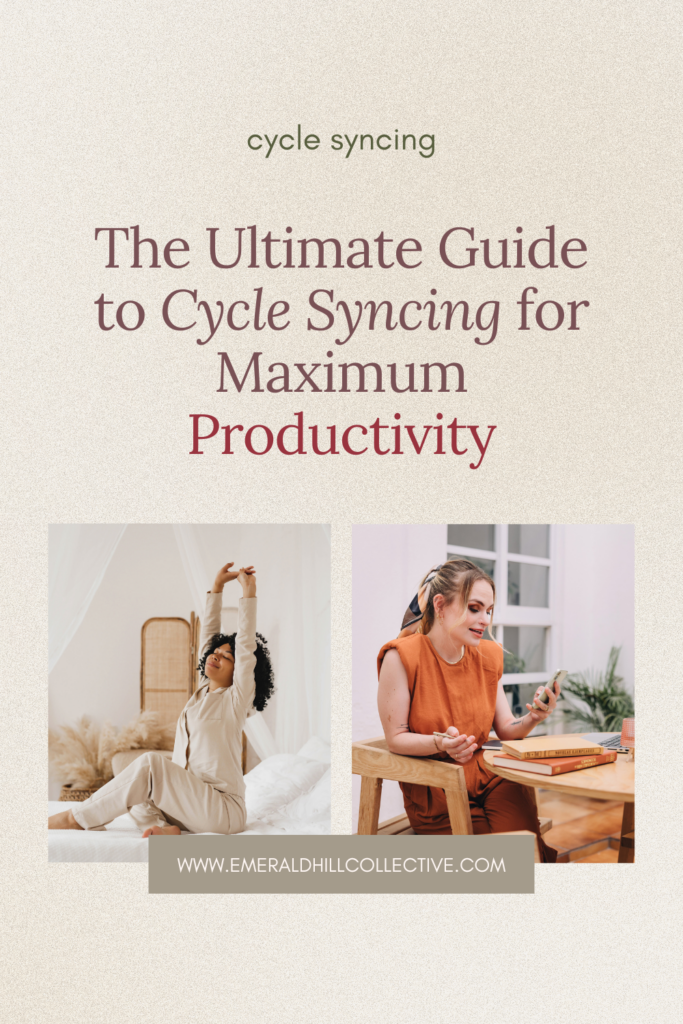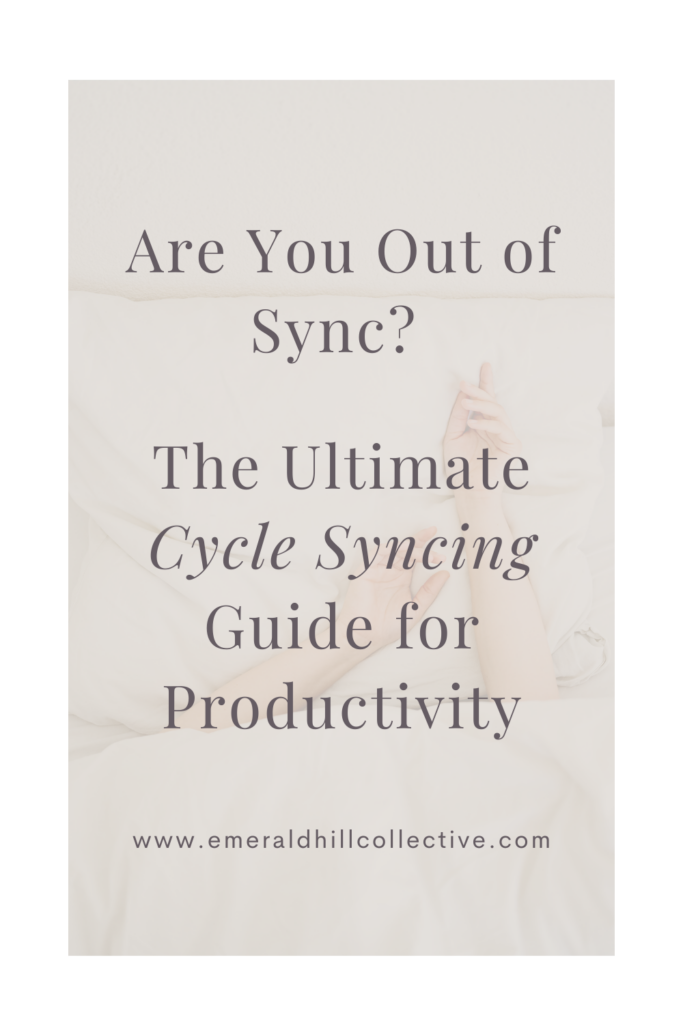
Ever feel like you’re on a rollercoaster of energy, seemingly at the whim of your menstrual cycle? Cycle Syncing can be the breakthrough you need.
One week you feel like you can conquer the world and the next week you’re struggling to stay on top of your emails. You efficiently check off your to-do list today, but come tomorrow, focusing on a grocery list seems like rocket science. Whether you’re looking to enhance your workplace productivity, take your fitness regimen to the next level, or simply gain better control over your emotions and energy levels,
Read on to learn all about the cycle syncing method, understanding your menstrual cycle, and how you can start using it to take control over your productivity and improve your quality of life!
Are You Out of Sync?: The Ultimate Cycle Syncing Guide for Productivity
This post may contain affiliate links, which means I’ll receive a commission if you purchase through my links, at no extra cost to you. Please read the full disclosure for more information.
Save this post for later in Pinterest!
Historical Mishaps: The Missing Menstrual Cycles
“Because women and people with cycles have been underrepresented in health research, we now know far less about how diseases affect women and people with cycles, in comparison to men”
– Ijeoma Unachukwu, M.S., Clue
Historically, medical research has given women’s health a bit of a cold shoulder. In fact, it wasn’t until 1993 that NIH-funded researchers were required to enroll women in clinical research trials.
Why? It turns out, the complexities associated with the women’s hormonal cycle, were too challenging for many researchers – leading to studies predominantly focusing on men. This is because male hormonal cycles are less varied compared to women’s cycles, making research easier and more predictable.
This has resulted in scientists making false assumptions about women’s bodies while only studying men’s bodies. Without taking into account factors like menstrual cycles and potential pregnancy, it has been assumed that women’s bodies simply behave similarly to men’s.
The Problem
As you may well know, our society operates strongly in alignment with the 24-hour circadian rhythm (i.e. the 9 to 5) – perfect for testosterone-based physiologies.
But here’s the scoop: those of us running on estrogen are on a 28-day cycle, or the Infradian Rhythm. For women, ignoring this cycle and purely focusing on the circadian rhythm can take a disastrous toll on our bodies. Talk about being out of sync!

Introducing Your Two Biological Clocks
The distinction between two biological cycles, the Circadian Rhythm and Infradian Rhythm will begin to paint a clearer picture of the estrogen-sized gap in the general wellness solutions we’re provided with.
The Circadian Rhythm: Your Internal Body Clock
The largely known biological clock is the Circadian Rhythm – a “24-hour internal clock in our brain that regulates cycles of alertness and sleepiness by responding to light changes in our environment.” The circadian clock is an inherent biological rhythm in both men and women that regulates our internal processes like sleep-wake patterns, body temperature, and metabolism
Because the male hormonal cycle primarily revolves around testosterone, their bodies will consistently follow this daily cycle. And it may sound like the day-to-day structure you’re familiar with.
It looks like this:
- Morning: Men have the most energy when they wake up. Testosterone and Cortisol levels are at their peak, making it great for their energy, communication, and focus.
- Afternoon: Testosterone begins to decline and this will be the best time for connecting with clients, colleagues, friends, dates, etc.
- Evening: Testosterone is at its lowest. So this the best time for relaxing and decompressing from the day.
The Infradian Rhythm: aka Your Second Clock
“It turns out that having an infradian rhythm, also known as our monthly cycle, causes changes in our metabolism, brain, stress, and other systems. Simply stated, we’re not the same throughout the 4 phases of our menstrual cycle. We have different calorie, fitness, and nutrient needs depending on which phase we are in.”
– Alisa Vitti, In the FLO
The lesser-known, Infradian Rhythm, is the second biological clock that creates a 25% change in a woman’s brain chemistry and directly affects things like hormonal fluctuations, body temperature, metabolism, energy levels, emotions, and cognitive function.
This causes your metabolism and cortisol to peak and dip throughout your monthly 28-day cycle – NOT daily like in the male hormonal cycle.
For women, these two biological clocks are crucial to your physical and mental health, but many wellness and productivity tips will only focus on the Circadian Rhythm. However, the distinction between the two is important because the circadian and infradian rhythms are so closely linked that any disturbance to either one can dramatically affect the other. For example, a change in sleep can affect period regularity while hormonal fluctuations affect your body temperature and sleep.

What is Cycle Syncing?
“[It is] a language and model for female-centered living”
– Alisa Vitti, In the FLO
Cycle Syncing is a concept pioneered by hormone expert and integrative nutritionist Alisa Vitti. At its core, Cycle Syncing is about harmonizing your diet, exercise, and daily activities by leveraging the natural rhythms of your menstrual cycle and unlocking your full inner power and potential.
By syncing up your activities with the distinct phases of your cycle – the Follicular, Ovulatory, Luteal, and Menstrual stages, you can tailor the way you use your energy for work commitments, physical fitness, social life, and downtime more effectively.
Of course, the key here is recognizing that Cycle Syncing isn’t a one-size-fits-all, cookie-cutter solution. As we identified earlier, women’s bodies are beautifully unique! Cycle Syncing provides the framework and guidelines for how to navigate your cycles while emphasizing the importance of being in tune with your own body’s signals and rhythms.
This means that the principles of Cycle Syncing can be incredibly personalized to your individual needs!
Related: 17 Ways to Getting the Most Out of Your Follicular Phase
The Benefits of Cycle Syncing
“For women, the menstrual cycle is the fifth vital sign and is just as important to your health as your heart rate, blood pressure, pulse and body temperature.”
– Dr. Rashmi Kudesia
Quick PSA: PMS (Premenstrual Syndrome) is not normal. PMS is NOT normal.
PMS symptoms stem from an imbalance of estrogen and progesterone during the luteal phase. And symptoms like severe cramps, mood swings, or brain fog are serious red flags indicating a hormonal imbalance. Cycle Syncing can help to alleviate many of these symptoms!
Understanding your menstrual cycle is about more than just managing discomfort. It can help you manage the health of your brain, immune system, metabolism, microbiome, and stress hormones. In fact, your menstrual cycle is so important that it is considered the fifth vital sign to your health.
This means that Cycle Syncing transcends surface-level benefits and is a powerful tool that leads to profound changes in your health.

Image: Styled Stock Society
Understanding Your Menstrual Cycle
The misconception of a menstrual cycle is that it’s usually thought of in the context of our periods. We have it or we don’t – like a switch that’s either on or off.
In reality, the menstrual cycle is cyclical as the name suggests. On average, it will be 28 days long but can vary from woman to woman. The four phases of your menstrual cycle are Follicular, Ovulatory, Luteal, and Menstrual.
Phase 1: Follicular Phase (Duration: 7 to 10 days)
Contrary to what we’re taught, the start of your bleed is not Day 1 of your cycle.
Day 1 begins right after your bleed ends.
In this phase, Estrogen levels rise as your body is busy preparing for the possibility of pregnancy. An egg undergoes maturation within the follicles of the ovary. These follicles are like tiny, fluid-filled sacs that nurture each immature egg. At the end of this phase, one of these eggs is released from its follicle – marking the start of ovulation.
Phase 2: Ovulatory Phase (Duration: 3 to 4 days)
In a healthy cycle, the ovulatory phase is the 3 to 4 days right after the follicular phase.
During ovulation, an egg is released from an ovarian follicle. These are your most fertile days! If this egg isn’t fertilized within about 24 hours, it will disintegrate and estrogen levels will fall throughout the rest of your cycle.
Phase 3: Luteal Phase (Duration: 10 to 14 days)
As you progress through your cycle, estrogen levels continue to rise steadily, contributing to the thickening of the uterine lining. At the same time, progesterone levels also start their ascent. By the end of this phase, you’ll find estrogen, testosterone, and progesterone levels hitting their peak before they take a dramatic nosedive, reaching their lowest right before your period. The luteal phase is also characterized by higher resting cortisol levels and a faster metabolism.
Phase 4: Menstrual Phase (Duration: 3 to 7 days)
If there is no pregnancy, estrogen peaks and declines along with progesterone levels and your uterus sheds the endometrial lining – leading to menstruation.

Image: Styled Stock Society
Your Guide to Cycle Syncing and Optimizing Productivity
“When you’re syncing with your cycle, you can stop trying to master time and start thinking about managing your energy.”
– Alisa Vitti, In the FLO
Your cycle and productivity are like two peas in a pod. In fact, The University of Virginia School of Medicine Health survey reported that 45.2% of women experienced menstrual symptoms that impacted their work. The key symptoms? Lack of energy, mood swings, and difficulty with concentration.
Understanding the hormonal changes that occur throughout your cycle can help you tailor your everyday activities and take full advantage of your energy and capabilities during each phase.
This includes:
- Boosting your productivity
- Elevating your work game
- Optimizing your fitness journey
- Enhancing your emotional balance
Use this section as a productivity guide when planning for your next cycle.
Phase 1: Follicular Phase
Throughout the follicular phase, your energy levels will gradually increase along with the boost in your estrogen levels. You’ll start to feel less tired and more motivated. You’re getting ready to get out there!
Longer work meetings? Intense strength training? Socializing at Happy Hour? All in the bag. You’re also buzzing with creative energy so use this time to tap into brainstorming, ideation, and planning new projects.
Productivity Focus
- Channel your creativity into brainstorming and launching new projects.
- Pursue activities that challenge your creative thinking.
- Set some big goals and strategize ways to achieve them.
Your brain is itching for fresh ideas and adventurous activities, so ride the energy wave and take advantage of that innovative spark!
Related: 17 Ways to Getting the Most Out of Your Follicular Phase
Phase 2: Ovulatory Phase
During this phase, estrogen levels surge, your testosterone is high, and it’s time to step on the gas! If you’re feeling ultra charismatic and more confident, it’s because this is the peak moment of your mindset. Your socialization skills will make you feel like a natural Casanova!
Your communication skills and assertiveness get a major boost so this is the best time to ask for a raise, give awesome presentations, or have important talks with loved ones. Think of adding some HIIT workouts to your routine, planning social gatherings, or collaborating on those big projects you’ve been working on.
Productivity Focus
- Schedule that important meeting or presentation.
- Spend time collaborating and networking.
- Pack your schedule with social gatherings!
Related: The Ovulatory Phase: 21 Productive Ways to Help Cycle Sync Your Life
Phase 3: Luteal Phase
As you navigate through the luteal phase, your body and brain are primed for detail-oriented tasks, bringing projects across the finish line, and making well-thought-out decisions. But as you reach the tail end of this phase, you may feel like your energy tank is running a bit low. You may also notice more mood swings.
This is your cue to tune into yourself. Instead of pushing your body to the limit, focus on gentler self-care and lower the intensity of your workouts to prevent that pesky cortisol from going through the roof. Think less HIIT and more Yoga, Pilates, or a relaxing walk. Your body will be super grateful for the change of pace.
Productivity Focus
- Zero in on tasks that demand your full attention and deep thinking.
- Embrace your knack for noticing the little things and making smart choices.
- Tackle those pending tasks that need a bit more focus.
- Reflect on your personal growth and areas where you want to evolve.
Phase 4: Menstrual Phase
Now is the time to fully embrace some R&R. Think of it as hitting the pause button for a bit of quiet. For your body and your mind!
Take a moment to recharge your batteries and check in with yourself. Grab a warm drink and break out the journal for some introspective reflection. Or become one with your couch and binge-watch your latest TV obsession. It’s the perfect opportunity to recharge, recenter, and have a well-deserved break.
Productivity Focus
- Make self-care and relaxation your top priority.
- Remain active in a gentle way with movements like yin yoga or a long walk.
- Reflect on your achievements and set intentions for the next cycle.

Note from the author: The contents of this blog post are intended for informational purposes and should not be considered medical advice. As the author, my expertise lies primarily through extensive research and experiences with my own body. It is crucial to consult with a healthcare professional for individualized medical guidance. This post is designed to encourage an informed and open-minded approach to understanding your body’s unique characteristics, wherever you are in your health journey.
Sources
- Alzheimer’s Disease Neuroimaging Initiative. “The Alzheimer’s Disease Neuroimaging Initiative: A review of papers published since its inception.” Alzheimer’s & Dementia, vol. 8, no. 1, 2012, pp. S1-S68, alz-journals.onlinelibrary.wiley.com/doi/epdf/10.1002/alz.12118.
- Patel, Sanjay R., and Frank A.J.L. Scheer. “Physiology, Circadian Rhythm.” NCBI Bookshelf, 1 Jan. 2020, www.ncbi.nlm.nih.gov/books/NBK519507/.
- Beery, Annaliese K., and Irving Zucker. “Women’s Involvement in Clinical Trials: Historical Perspective and Future Implications.” PubMed Central (PMC), 8 Mar. 2011, www.ncbi.nlm.nih.gov/pmc/articles/PMC4800017/.
- “Infradian Rhythm: Your Guide to a Perfect Cycle.” Flo Living, www.floliving.com/blog/infradian-rhythm.
- “Menstrual Symptoms Affect Workplace Productivity, Study Finds.” UPI, 2 Feb. 2023, www.upi.com/Health_News/2023/02/02/menstrual-symptoms-workplace-productivity-study/7951675314092/.
- “Pandemic Periods: Why Women’s Menstrual Cycles Have Gone Haywire.” The Guardian, 25 Mar. 2021, www.theguardian.com/society/2021/mar/25/pandemic-periods-why-womens-menstrual-cycles-have-gone-haywire.
- “Prevalence of Premenstrual Syndrome and Its Impact on Quality of Life among Selected College Students in Puducherry.” The National Medical Journal of India, nmji.in/prevalence-of-premenstrual-syndrome-and-its-impact-on-quality-of-life-among-selected-college-students-in-puducherry/.
- “Why Are Women and People with Cycles Underrepresented in Health Research?” HelloClue, www.helloclue.com/articles/culture/why-are-women-and-people-with-cycles-underrepresented-in-health-research.
- “Why Nearly 80 Percent of Autoimmune Sufferers Are Female.” Scientific American, www.scientificamerican.com/article/why-nearly-80-percent-of-autoimmune-sufferers-are-female/.




Leave a Reply